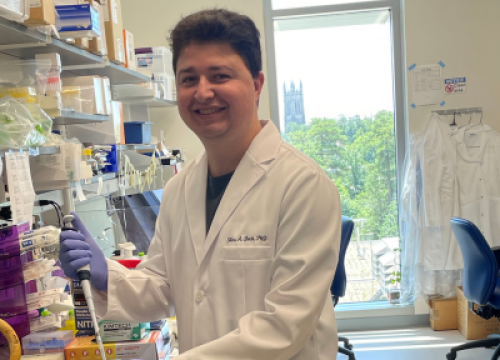Disease-Modifying Research Pipeline Holds Possibility for Parkinson’s

Though there is still a lot we don’t know about Parkinson’s disease (PD), therapies aimed at modifying disease progression are poised for major breakthroughs. Researchers are excited about the potential of current studies to improve, slow or someday stop PD.
This article is based on Research Update: Working to Halt PD, a Parkinson’s Foundation Expert Briefing webinar presented by Lorraine Kalia, MD, PhD, FRCPC, assistant professor in the Division of Neurology, Department of Medicine at the University of Toronto and scientist at Toronto Western Research Institute and Tanz Centre for Research in Neurodegenerative Disease.
Understanding PD Progression
Parkinson’s is not a static condition — it's an intricate, progressive disease that evolves over time. Uncovering its many complexities is one of the challenges PD researchers face as they work toward halting its progression.
As people age, the loss of some brain cells is expected. In Parkinson’s this loss happens at a much faster rate. Neurodegeneration, the progressive loss of neurons that produce dopamine — a feel-good chemical related to movement, mood and more — is tied to movement and non-movement symptoms that develop in PD. As time progresses, new symptoms may develop or worsen.
Right now, we have therapies that can treat Parkinson’s symptoms — lessening tremor, easing mobility, improving mood and more — but we can’t stop the disease. Research is at the beginning stages of discovering disease-modifying therapies that might slow or stop the loss of dopamine-producing neurons.
Exploring Disease-Modifying Therapies
Therapies that can potentially change the course of Parkinson’s are rapidly evolving. A 2023 analysis of 139 PD drug therapy clinical trials registered as active on the ClinicalTrials.gov website showed 76 were investigating symptomatic treatments and another 63 were exploring disease-modifying therapies.
Though these therapies are still on the horizon for use in PD, the first drug to change the course of multiple sclerosis (MS) — a condition that affects a person’s spinal cord and brain and spine — was discovered in 1993. Now, there are more than 20 disease-modifying therapies for MS. One reason medications to slow MS progression have been so successful is that scientists have a way to identify the disease and observe its response to therapies. This is known as a biomarker.
Researchers are beginning to discover possible biomarkers related to Parkinson's. PD is tied to the abnormal clumping of a protein called alpha-synuclein in the brain. Alpha-synuclein can act as a biomarker in PD. Reliable biomarkers can potentially lead to the ability to diagnose Parkinson’ sooner, track disease progression and help researchers design and test therapies that might change the course of the disease.
Changing the Course of PD
Neurodegeneration in Parkinson’s — progressive damage to normal, healthy brain cells — can cause cell dysfunction and death. This process may be reversible. Cell protection is an approach that seeks to slow or prevent this process.
Areas of research that focus on cell protection are expected to show the most progress in the near future. They include:
Exercise
One of the most important PD symptom management tools, it improves heart, muscle and bone health, lung function, as well as cognitive and mental health. Exercise can also reduce the risk of fractures and falls. Research shows it can also help maintain movement in Parkinson’s, slow disease progression and improve symptoms; it may also provide cell protection.
Studies suggest exercise might reduce inflammation in PD and increase growth factors — proteins that stimulate cell growth and influence how a cell functions.
Alpha-synuclein
This protein is abundant in the brain. Though it’s unclear why, alpha-synuclein malfunctions in PD and the proteins start to misfold and stick together, forming increasing buildups. These ultimately form Lewy bodies.
Brain cells are complex and require several healthy components to function. Researchers think malformed alpha-synuclein can disrupt these cell functions and can impact nearby brain cells. Targeting misfolded alpha-synuclein may protect brain cells from dying. There are many potential ways to do this. Researchers are currently exploring prescription therapies that could:
- Reduce alpha-synuclein production in the cell (Buntanetap ION464.)
- Degrade corrupt alpha-synuclein (Minzasolmin.)
- Reduce or prevent problematic alpha-synuclein moving from one cell to another (Prasinezumab ACI-7104.056 and UB-312.)
GBA1 and LRRK2 Genes
There is a connection between genetics and Parkinson’s. GBA is the most common Parkinson's-related gene, occurring in 5 to 10% of people with PD. Carriers may experience PD symptoms at an earlier age compared to those who do not have a genetic form of PD. LRRK2 is involved in about 5% of people with a family history of Parkinson’s. Carriers may have milder symptoms of dementia and depression.
Lysosome, one of the disposal systems of the cell, is an enzyme that breaks down and gets rid of waste. One thing it may get rid of is alpha-synuclein. GBA lives within the lysosome. In people with a GBA gene mutation, the lysosome enzyme may be underactive. Researchers are currently exploring prescription therapies that could enhance lysosome activity and make it work better.
In Parkinson’s, a LRRK2 mutation impacts the autophagy lysosomal pathway, another cell waste disposal system, causing overactivity. Slowing this activity might reduce neurodegeneration. BIIB094 and BIIB122, intended to curb this excess activity, are currently in clinical trial.
Repurposing Existing Drugs
Therapies already approved for other diseases may hold great potential in Parkinson’s. If proven effective, they can be fast-tracked to begin treating people with PD because they have already gone through clinical trials to demonstrate their safety.
More than one-third of the drugs in current PD clinical trials being tested as potential disease-modifying therapies are repurposed drugs.
Amantadine is an example of drug repurposing in Parkinson’s as it was originally developed as a flu treatment. In the 1960s, a woman with PD taking amantadine for the flu told her doctor her Parkinson’s symptoms felt much better. Subsequent clinical trials confirmed the benefits of amantadine on some PD symptoms. The medication was initially prescribed for movement symptoms, before levodopa became the most effective, widely available Parkinson’s drug. Today, amantadine is primarily used to treat dyskinesia.
Ambroxol is currently approved as a cough suppressant and is in clinical trial to enhance GBA activity. It has quickly moved from Phase II onto Phase III clinical trials.
GLP-1 receptor activators are another category of medications that may hold major disease-modifying potential, are currently making headlines. These drugs were primarily developed for diabetes (one of the most familiar brand names in the category is Ozempic).
GLP-1 receptor activators bind to a receptor on the outside of a cell, causing a chain of activities that can potentially improve memory, cell survival and effects of mitochondria, while reducing inflammation and alpha-synuclein. Exenatide is the first of these to be tested. Various versions of it, NLY01 (slow-release) and PT320 (pegylated), have been or are in clinical trials.
Two related medications, Liraglutide and Lixisenatide, have been or are also in clinical trials. The results of a phase II trial of Lixisenatide published in the April 3, 2024 New England Journal of Medicine are causing a lot of excitement. Lixisenatide therapy in participants with early PD resulted in less motor disability progression than placebo at 12 months. The study is poised to move on to a phase III trial.
Cell Replacement
Early studies to investigate whether brain cells could be replaced in Parkinson's isolated and removed dopamine-making stem cells from human fetal tissue and grafted them into the brains of research participants with PD. While the research showed promise, nuances and complications limited long-term research.
Remarkable advances in stem cell technology over the past decade have led to the ability to make dopamine-producing cells from a person’s blood or skin cells or from embryonic stem cells, unlocking a new generation of stem cell research. There are ongoing clinical trials in countries around the world, including the U.S., investigating potential benefits in Parkinson's.
Cautious Optimism
Parkinson's disease looks different for different people. Different causes may spur its development. Multifaceted research is essential to moving forward.
Science must keep an open mind, follow the evidence and — when disease-modifying treatments become available — target people with the right treatments at the most impactful stages of the disease.
Ultimately, Parkinson’s is a global disease with symptoms and a rate of progression that is unique to each person living with it. It is important to pursue different avenues of research because there may be more than a single cure.
Learn More
The Parkinson’s Foundation works improve care for people with PD and advance research toward a cure.
- Discover how we are working to close gaps in knowledge about PD: Advancing Research
- Explore ongoing Parkinson’s research studies: Join A Study
Learn about PD GENEration — a global genetics study that provides genetic testing and counseling at no cost for people with Parkinson’s.
Related Materials
Related Blog Posts

Neuro Talk: What’s Next for PD Research

